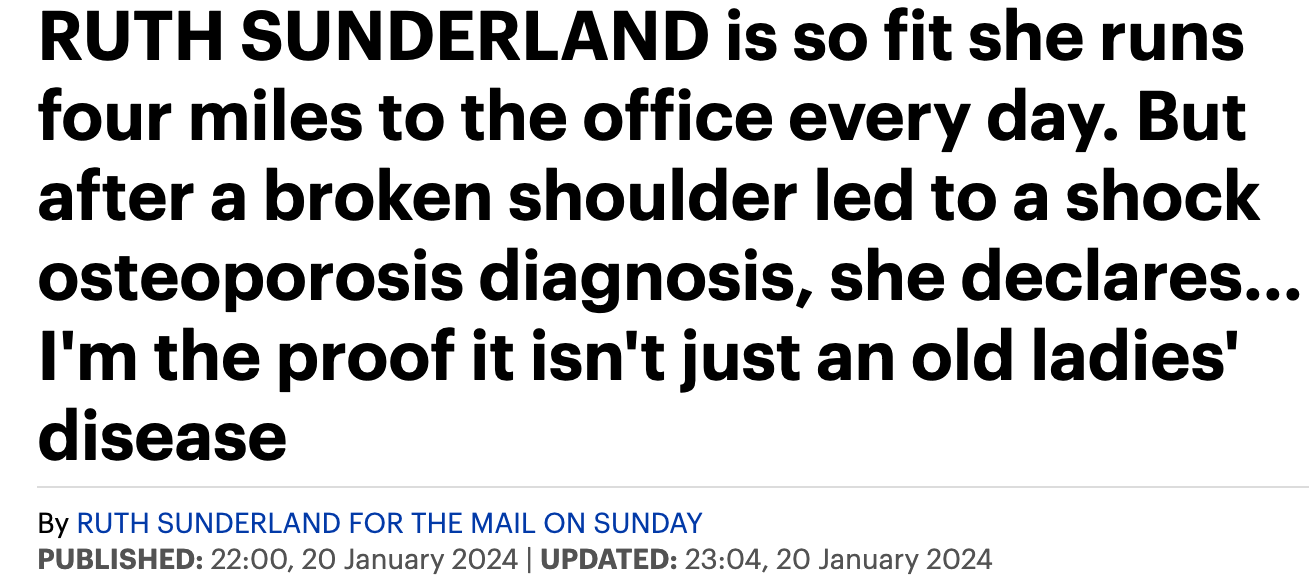The Misconception Shattered
Ruth Sunderland’s experience, as shared in the Daily Mail, shatters a common misconception about osteoporosis: that it’s an ailment only afflicting the elderly. Ruth, a fit and healthy woman in her 50s and a professional at the peak of her career, never imagined that a simple fall could lead to a diagnosis of osteoporosis. This incident serves as a potent reminder that osteoporosis is not just an “old ladies’ disease” but a condition that can affect anyone at any stage of life.
A Small Misstep with Big Consequences
Miss Sunderland’s ordeal began with a fall caused by tripping over a tree root on Clapham Common while training for a half-marathon. What seemed like a minor injury led to a shocking discovery. Her fractured shoulder, initially dismissed as a sporting injury, was the first sign of a deeper, underlying issue with her bone health.
Osteoporosis: Not Just a Women’s Issue
This condition is often wrongly perceived as exclusively affecting women, particularly post-menopausal. However, it’s crucial to understand that men are also at risk. The broadcaster and author Iain Dale’s osteoporosis diagnosis following a hip fracture is a testament to this fact. Over 81,000 working-age individuals suffer fractures annually due to osteoporosis in the UK, and a significant portion of these are men. This highlights the importance of awareness and early diagnosis for all. There are over 800,000 men with osteoporosis in the UK. Often, the diagnosis of osteoporosis is delayed in men.
The Economic and Personal Impact
Beyond the personal health implications, Miss Sunderland’s perspective as a Business Editor sheds light on the broader economic impact of osteoporosis. The loss of productivity and job cessation following fractures among working-age individuals is a significant concern. Early diagnosis and treatment are not only crucial for individual health but also for maintaining economic productivity.
The Path to Diagnosis and Management
Miss Sunderland’s journey from the initial fracture to her eventual diagnosis underscores the critical role of timely medical intervention. Her experience with a DEXA scan, which diagnosed her condition, emphasizes the importance of such diagnostic tools in detecting and managing osteoporosis.
Lifestyle and Treatment Choices
Contrary to the assumption that lifestyle choices solely dictate bone health, Ruth’s case reveals that osteoporosis can affect even those with healthy habits. Nonetheless, maintaining a balanced diet, regular weight-bearing exercise, and avoiding smoking and excessive alcohol are essential preventative measures. Miss Sunderland’s decision to continue running and hiking, along with her treatment involving the new drug romosozumab, illustrates that there are options for managing this condition.
A Call to Action
Ruth Sunderland’s story is a wake-up call for everyone, regardless of age or gender. It’s crucial to take proactive steps in assessing and maintaining bone health. We encourage you to take our Bone Health Quiz at GOF Bone Health Test to understand your risk and take appropriate action.
If you discover you’re at risk or have already been diagnosed with osteoporosis, know that support and treatment are available. Visit eosteo.org for various resources, including a series on osteoporosis and consider contacting the London Osteoporosis Clinic for specialised care.
Osteoporosis is a silent disease, often remaining unnoticed until a fracture occurs. But stories like Ruth Sunderland’s serve as essential reminders that awareness, early detection, and proactive management can make a significant difference. Let’s break the silence around osteoporosis and take steps towards better bone health.

